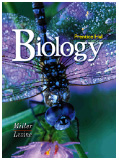BIOLOGY
by Miller & Levine
[complete Table of Contents]

|
Use the pull-down menu to jump to any of the Book's 40 Chapters: |
Additional
Resources:
An incredibly complete site (from Florida State Univ.) complete with special sections on the optics and history of the microscope, and even a series of web-operated virtual microscopes. Be sure not to miss the Virtual SEM - a Scanning Electron Microscope you can "operate" over the web!)

NATURE
retracts a report on transgenic corn
A recent (2002) example of a major scientific journal acknowledging
an apparent mistake in one of its research reports.
Chapter
1 ![]()
The Science of Biology
In this chapter, you will find out about the process of science and how scientists work. You will also explore the nature of life and how scientists study living things The links below lead to additional resources to help you with this chapter. These include Hot Links to Web sites related to the topics in this chapter, the Take It to the Net activities referred to in your textbook, a Self-Test you can use to test your knowledge of this chapter, and Teaching Links that instructors may find useful for their students
| Take it to the Net | |
| Chapter Self-Test | Teaching Links |
![]()
Section 1-1:
What Is Science?
![]() The goal of science
is to investigate and understand nature, to explain events in nature,
and to use those explanations to make useful predictions.
The goal of science
is to investigate and understand nature, to explain events in nature,
and to use those explanations to make useful predictions.
Section 1-2:
How Scientists Work
![]() Whenever possible,
a hypothesis should be tested by an experiment in which only one variable
is changed at a time. All the other variables should be kept unchanged,
or controlled.
Whenever possible,
a hypothesis should be tested by an experiment in which only one variable
is changed at a time. All the other variables should be kept unchanged,
or controlled.
 In science, the word theory applies
to a well-tested explanation that unifies a broad range of observations.
In science, the word theory applies
to a well-tested explanation that unifies a broad range of observations.
Section 1-3:
Studying Life
![]() Living things
share characteristics including cellular organization, reproduction, a
universal genetic code, growth and development, use of materials and energy,
response to their environment, and maintaining an internal stability.
Living things
share characteristics including cellular organization, reproduction, a
universal genetic code, growth and development, use of materials and energy,
response to their environment, and maintaining an internal stability.
![]() Living organisms
can be studied at different levels of organization, from the molecular
level to the biosphere.
Living organisms
can be studied at different levels of organization, from the molecular
level to the biosphere.
Section 1-4:
Tools and Procedures
 Most scientists use the metric system
when collecting data and doing experiments.
Most scientists use the metric system
when collecting data and doing experiments.
 Light microscopes produce images by focusing
visible light rays. Electron microscopes produce images by focusing beams
of electrons.
Light microscopes produce images by focusing
visible light rays. Electron microscopes produce images by focusing beams
of electrons.
(Complete Index of Articles)